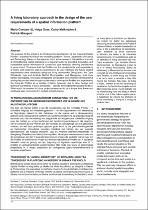 ResearchSpace
ResearchSpace
A living laboratory approach in the design of the user requirements of a spatial information platform
JavaScript is disabled for your browser. Some features of this site may not work without it.
- ResearchSpace
- →
- Research Publications/Outputs
- →
- Journal Articles
- →
- View Item
| dc.contributor.author |
Coetzee, M

|
|
| dc.contributor.author |
Goss, H

|
|
| dc.contributor.author |
Meiklejohn, C

|
|
| dc.contributor.author |
Mlangeni, P

|
|
| dc.date.accessioned | 2015-10-07T06:18:44Z | |
| dc.date.available | 2015-10-07T06:18:44Z | |
| dc.date.issued | 2014-05 | |
| dc.identifier.citation | Coetzee, M, Goss, H, Meiklejohn, C, and Mlangeni, P. 2014. A living laboratory approach in the design of the user requirements of a spatial information platform. Town and Regional Planning, vol. 64, pp 10-18 | en_US |
| dc.identifier.issn | 1012-280X | |
| dc.identifier.uri | http://hdl.handle.net/10204/8163 | |
| dc.description | Copyright: 2014 University of the Free State (UoFS) | en_US |
| dc.description.abstract | The purpose of this article is to introduce the development of the Regional Spatial Profiler – a spatial information and modelling platform – for the Department of Science and Technology. Based on the steps set out in action research, this platform is aimed at strengthening spatial planning at a regional scale by providing accessible and comparable spatial information (of current and past trends) to planning practitioners in government. To ensure that the Profiler met the requirements and expectations of users, and would be used by practitioners, its user-interface and future content requirements were developed using four living laboratories (living labs): the Cape Winelands, Ugu and Amatole District Municipalities, and Mangaung Local (now Metro) Municipality. Municipal participants and project team members believed that a living-lab process was the appropriate way to develop the Profiler and experienced the living-lab Profiler as a positive initiative; however, due to time, budget and technical constraints, it was a temporally – specific and fragmented project initiative. What would be required in future project phases would be a longer time frame and continued user involvement in multiple project phases. | en_US |
| dc.language.iso | en | en_US |
| dc.relation.ispartofseries | Worklist;14694 | |
| dc.subject | Regional spatial profiler | en_US |
| dc.subject | Spatial information | en_US |
| dc.subject | Living laboratories | en_US |
| dc.title | A living laboratory approach in the design of the user requirements of a spatial information platform | en_US |
| dc.type | Article | en_US |
| dc.identifier.apacitation | Coetzee, M., Goss, H., Meiklejohn, C., & Mlangeni, P. (2014). A living laboratory approach in the design of the user requirements of a spatial information platform. http://hdl.handle.net/10204/8163 | en_ZA |
| dc.identifier.chicagocitation | Coetzee, M, H Goss, C Meiklejohn, and P Mlangeni "A living laboratory approach in the design of the user requirements of a spatial information platform." (2014) http://hdl.handle.net/10204/8163 | en_ZA |
| dc.identifier.vancouvercitation | Coetzee M, Goss H, Meiklejohn C, Mlangeni P. A living laboratory approach in the design of the user requirements of a spatial information platform. 2014; http://hdl.handle.net/10204/8163. | en_ZA |
| dc.identifier.ris | TY - Article AU - Coetzee, M AU - Goss, H AU - Meiklejohn, C AU - Mlangeni, P AB - The purpose of this article is to introduce the development of the Regional Spatial Profiler – a spatial information and modelling platform – for the Department of Science and Technology. Based on the steps set out in action research, this platform is aimed at strengthening spatial planning at a regional scale by providing accessible and comparable spatial information (of current and past trends) to planning practitioners in government. To ensure that the Profiler met the requirements and expectations of users, and would be used by practitioners, its user-interface and future content requirements were developed using four living laboratories (living labs): the Cape Winelands, Ugu and Amatole District Municipalities, and Mangaung Local (now Metro) Municipality. Municipal participants and project team members believed that a living-lab process was the appropriate way to develop the Profiler and experienced the living-lab Profiler as a positive initiative; however, due to time, budget and technical constraints, it was a temporally – specific and fragmented project initiative. What would be required in future project phases would be a longer time frame and continued user involvement in multiple project phases. DA - 2014-05 DB - ResearchSpace DP - CSIR KW - Regional spatial profiler KW - Spatial information KW - Living laboratories LK - https://researchspace.csir.co.za PY - 2014 SM - 1012-280X T1 - A living laboratory approach in the design of the user requirements of a spatial information platform TI - A living laboratory approach in the design of the user requirements of a spatial information platform UR - http://hdl.handle.net/10204/8163 ER - | en_ZA |





